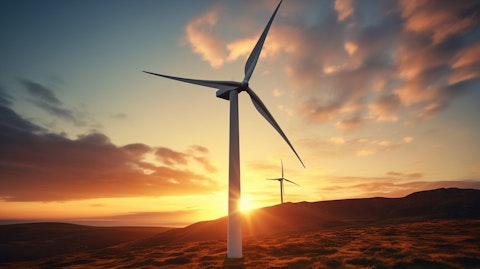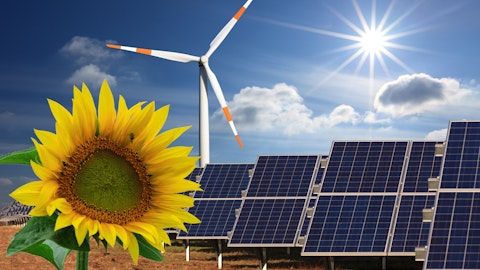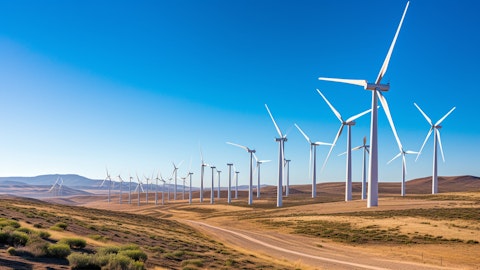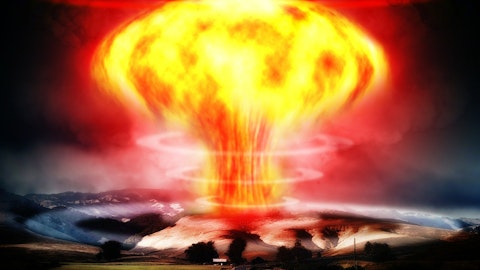Constellation Energy Corporation (NASDAQ:CEG) Q3 2023 Earnings Call Transcript November 6, 2023
Operator: Good day, ladies and gentlemen, and welcome to the Constellation Energy Corporation Third Quarter 2023 Earnings Call. At this time, all participants are in a listen-only mode. Later, we will conduct a question-and-answer session and instructions will follow at that time. As a reminder, this call may be recorded. I would now like to introduce your host for today’s call, Emily Duncan, Senior Vice President, Investor Relations. You may begin.
Emily Duncan: Thank you, Abigail. Good morning, everyone, and thank you for joining Constellation Energy Corporation’s Third Quarter Earnings conference call. Leading the call today are Joe Dominguez, Constellation’s President and Chief Executive Officer, and Dan Eggers, Constellation’s Chief Financial Officer. They are joined by other members of Constellation’s senior management team who will be available to answer your questions following our prepared remarks. We issued our earnings release this morning along with the presentation, all of which can be found in the Investor Relations section of Constellation’s website. The earnings release and other matters, which we discuss during today’s call contain forward-looking statements and estimates regarding Constellation and its subsidiaries that are subject to various risks and uncertainties.
Actual results could differ from our forward-looking statements based on factors and assumptions discussed in today’s material and comments made during this call. Please refer to today’s 8-K and Constellation’s other SEC filings for discussions of risk factors and other circumstances and considerations that may cause results to differ from management’s projections, forecasts and expectations. Today’s presentation also includes references to adjusted EBITDA and other non-GAAP measures. Please refer to the information contained in the appendix of our presentation and our earnings release for reconciliations between the non-GAAP measures and the nearest equivalent GAAP measures. I’ll now turn the call over to our CEO of Constellation, Joe Dominguez.
Joe Dominguez: Thanks, Emily. Thanks to the operator for getting us started. Good morning, everyone. Thanks for joining our call. I apologize if the quality of the audio isn’t great. We are all, if you could believe it, sitting around Emily Duncan’s cell phone here because we lost a trunk line into the building. But as you could see from our numbers, pretty much everything else is going well around here. I want to begin by thanking the good people of Constellation for delivering an awesome third quarter. They continued the strong performance from the first half of the year and they are the best at what they do. For the third quarter, we earned $1.199 billion in adjusted EBITDA. As a result of this continued strong performance, we are again raising our full year guidance range to $3.8 billion to $4 billion.
The strength is not limited to 2023, and you will see in our disclosures that we have raised our 2024 gross margin by $250 million. I want to emphasize here that STP is not yet in our final disclosures for 2024. As you recall, we estimated the average STP EBITDA contribution to be an incremental $190 million per year with 2024 a little lower due to the fact that we have an extra outage every third year. And as it so happens, 2024 is one of those years. However, we believe that the impact of that extra outage will be offset by the higher Texas energy prices we have seen since we’ve announced the transaction. So we’re back to an estimated $190 million for 2024 with 2025 looking even better. We will provide all of the STP and other updated financials in our fourth quarter call.
We talked about this before, but it bears repeating. Constellation owns the largest and most reliable clean energy fleet in the country and has the best C&I and commercial platform in the business. We strategically couple these businesses with a strong balance sheet that, in turn, gives us a powerful competitive advantage across retail and wholesale channels. It translates into a unique ability to give our customers the certainty and visibility that they want on energy costs as well as to provide to them sustainability solutions. All of that ultimately leads to margin expansion and creates value for you. Before I turn to the operational performance, I want to talk about some exciting developments since our last call. First, as I noted earlier, we closed ahead of schedule on our acquisition of 44% of the South Texas Project, expanding our clean, reliable annual nuclear production to approximately 180 million megawatt hours.
We’re looking forward to working and forging a strong relationship with our new co-owners, Austin Energy and CPS. This includes working to resolve pending litigation and explore mutually beneficial opportunities to improve performance. I talked last quarter about the fact that an average outage at STP lasts around 31 days. At Byron, we just completed an outage for a very similar machine in 17 days. And if you think that’s amazing, consider that we just completed the Peach Bottom outage in 13 days. I was happy to see that, Bryan Hanson, our Chief Generation Officer, was named as Chairman of the STP Board and will begin immediately to realize some of the opportunities we see in that asset. The second development I want to highlight is that the US Department of Energy awarded a $1 billion grant to the Midwest Hydrogen Hub, which includes our hydrogen project at LaSalle.
A portion of this award will offset our cost for the project. The award is proof that the DOE and the administration want existing nuclear energy to play a vital role in jump-starting domestic clean hydrogen production. However, it remains critical that the Treasury Department guidance confirms that using existing nuclear energy to produce hydrogen qualifies for the full clean energy production tax credit. Certainly, we think that the hub award is a good sign, but we need to see the right rules or the hub won’t happen. Third, we signed a deal with ComEd to power its facility with hourly matched clean free — carbon-free energy, which I’ll cover in more detail in a few minutes. And finally, probably the most exciting thing is that we earned a 2023 Great Place to Work certification.
Really proud of this because it’s based on how our employees rate their experience at Constellation. 5,000 of our colleagues participated in the survey and 81% of them said that Constellation is a great place to work. That’s 24 percentage points higher than the average US company. Our people are talented, hard-working and they’re passionate about what they do, and that shows up in our results over and over again. Our culture and our mission is also an asset in attracting the best talent in the market. We’ve onboarded 3,000 new colleagues since separation and that’s pretty incredible for a workforce of about 14,000 people. Now I’ll turn to the quarterly operational updates, starting on Slide 6. During the hottest summer on record, our fleet helped to support the grid and ensure that American families can cool their homes and that businesses have the electricity to power our economy.
Our nuclear plants had a third quarter capacity factor of 97.2% but they ran at nearly 100% during June, July and August. The only reason we’re at 97.2% is that, in September we started our planned refueling outages. Our power and renewable assets also ran extremely well. Our Texas fleet, which includes state-of-the-art CCGTs, produced 1.4 million megawatt hours more this year than last year, supporting ERCOT during an extremely challenging summer. This summer, ERCOT was affected not only by extreme heat, but by unprecedented load and the impacts of a changing resource mix. For example, during the summer, ERCOT had 49 days with a peak higher than 80 gigawatts, exceeding the all-time summer peak demand set in ’22 and exceeding 2021’s peak by nearly 11.8 gigawatts or an incredible 16%.
The system is constrained not just at peak, but in the hours after peak due to the intermittent output that comprises much of its generation portfolio. As the grid continues to change, we expect these conditions to amplify, and challenges could occur at any hour. The changes in ERCOT stack and the hours of challenging operating conditions will increase the importance of dispatchable generation and particularly clean, reliable, dispatchable generation. The quality of our gas fleet, coupled with our newly acquired STP assets, sets us up for great success. I want to send a special thank you to the people who operate our nuclear and power fleets for all that they do. Now let me move to Slide 7. The success of the Commercial business is the foundation for our financial performance.
This year, they knocked the cover off the ball. We’re able to optimize our positions across both the generation and customer portfolios to create additional gross margin. And we can provide our customers certainty on energy bills in volatile times, which leads to margin expansion. We’re also leading the way on sustainability solutions. In the second quarter, we spent time talking about the Microsoft deal where we use nuclear and renewable energy to produce a time-matched clean energy product. We continue to see very strong interest in this product. This quarter, we’re excited to announce an agreement with one of the largest utilities in the country, ComEd, to power its facilities with hourly match carbon-free energy from nuclear power. Microsoft and ComEd are both sustainability leaders, and we’re thrilled to be able to help them move forward in their efforts to address the climate crisis through the recognition of the importance of 24/7 carbon-free electricity made by nuclear energy.
Matching regionally produced clean energy to the exact moment when a customer uses energy is essential to reaching carbon reduction goals while maintaining electric reliability and affordability. That is why our nuclear fleet is essential today and will be even more valuable tomorrow. With that, I’m going to turn it over to Dan for the financial update.

Dan Eggers: Thank you, Joe, and good morning, everyone. Beginning on Slide 8, as Joe mentioned, the business continues to perform extremely well. We earned $1.199 billion in adjusted EBITDA in the third quarter, which compares to $592 million in the third quarter of last year. Our commercial organization continued with the success we have seen over recent quarters. Our renewal rates have been strong and margins remain above historical levels as market volatility and the desire of customers to control their budgets have created opportunity for our team. As we’ve discussed on prior calls, the volatility in commodity markets and higher interest rates are leading to more appropriate risk pricing by our competitors. These market conditions create opportunity for us to optimize our combined portfolio of generation and load, which we see in results for 2023.
And as we look out to ’24 and ’25 with favorable gross margin uplift that I’ll talk about in a moment. On the generation front, our nuclear and power fleet performed extremely well during a record-setting hot summer. As Joe said, our nuclear fleet ran full out during June, July and August. And as a result of the extreme heat and load growth in Texas, ERCOT set 10 new peak demand records during the summer. In addition to record peaks, we observed more significant operating conditions in the subsequent hours after the peak load due to low intermittent output and a stretched thermal fleet which, at times, resulted in prices above $1,000 a megawatt hour and with a $5,000 cap for a few hours. Investments we made in our Texas fleet in advance of summer ensured we were ready to help support the grid when the plants were needed, and they ran more than they did the previous year.
Through September, our Texas plants ran 13% more than they did last year. Turning to Slide 9 and our gross margin outlook. We have increased our gross margin forecast for 2023 and 2024, incorporating the continued strong execution and performance Joe and I have discussed. For 2023, total gross margin increased by $400 million to $9.2 billion. Our projected gross margin is now $850 million higher than our expectations when we began the year, reinforcing the unparalleled operating environment we have seen this year. In 2024, our total gross margin including PTCs is $9.45 billion. Total gross margin increased by $250 million from our last update. Market prices increased across the major regions relative to last quarter. As a result, we expect to earn less nuclear PTC revenues at our four plants without state support due to higher expected gross receipts.
Turning to our Commercial business. As we renew existing contracts and enter into new ones, we are seeing the favorable margin trends with our C&I customers and load auctions extending out into 2025. We have seen some moderation in margins from highs earlier this year and more participants in load auctions, but see opportunity for these margin trends to continue for some time as we anticipate sustained commodity market volatility, in part, due to the changing composition of the generation stack. With the strength of our balance sheet, along with our integrated generation and load business, we are well positioned during this volatile environment to continue meeting our customers’ needs while also creating value for our shareholders. Moving to Slide 10.
We are raising our full year adjusted EBITDA guidance outlook by $400 million to a $3.9 billion midpoint and narrowing the range to $3.8 billion to $4 billion. This upward revision reflects the significant increase to our gross margin forecast since the beginning of the year. And as we flagged last quarter, the gross margin upside is somewhat tampered by an increase to O&M, driven primarily by increased compensation for our employees, including stock compensation due to the strong financial performance of the company. I should note that considering that we just closed the STP acquisition last week, our gross margin and cost forecast do not yet reflect STP. We’ll layer that plant into our year-end disclosures. That said, our updated EBITDA guidance for 2023 includes STP for November and December, which is a relatively small part of the increase to our guidance.
And as Joe mentioned in his remarks, we anticipate contribution from STP to at least meet the $190 million of EBITDA starting in 2024, which again is not reflected in the gross margin or cost disclosures in our earnings materials today. Turning to the financing and liquidity update on Slide 11. To help fund the STP transaction, we issued $1.4 billion of debt, including $900 million of 30-year and $500 million of 10-year senior unsecured notes. We saw significant demand with order books peaking at seven times across both tranches. We also achieved very tight pricing when we look at both spreads to treasuries and between the 10 and 30-year tranches, pricing competitively with recent utility holding company transactions. We appreciate the support from our fixed income owners and the vote of confidence in the long-term need for our assets into the 2050s and well into their next licensed lives to 80 years.
As we stated at the time of the announcement, the transaction will be credit-neutral and a debt issuance did not strain our forward credit metrics. In fact, our credit metrics are now projected to be at or above the 35% at Moody’s and 45% in S&P that we laid out at the beginning of the year due to the additional cash flows captured in our earnings guidance. We continue to execute on our commitments to return capital to our shareholders. Completed another $250 million of share buybacks during the third quarter. When we look at the opportunities ahead of us, we still see our stock is attractive at current levels and will continue to be opportunistic with the remaining $250 million authorized by our Board. As we discussed in June, we have $1.2 billion of unallocated capital for 2023 and 2024, which will be used to create additional shareholder value through growth investments, M&A or return of capital to our owners.
I should remind you that this $1.2 billion is based on our disclosures at year-end 2022 that we shared on the fourth quarter call and does not reflect any additional cash created by this year’s outperformance and upward revisions to next year’s expectations. We’ll provide an updated view of all this on our fourth quarter call. I’ll turn the call back now to Joe for his closing remarks.
Joe Dominguez: Thanks, Dan. So the management team here remains focused on creating value for our shareholders. You know our business is unique, and we continue to have many unique opportunities in front of us. As you know, we’re the best operator of nuclear plants and the largest producer of carbon-free electricity in the US. And now with STP, we’ll make more than 180 million-megawatt hours annually just from our nuclear fleet. Our Commercial business serves more than 22% of the competitive C&I market in the United States and is helping customers like Microsoft and ComEd meet their sustainability goals through products like our hourly matching product. Our businesses are essential to addressing the climate crisis and our assets are durable.
The IRA provides long-term commitment to nuclear energy as part of the national security of this great nation. We have many ways to grow and bring even more value to our shareholders against a baseline earnings level supported by the PTC. And over the life of the PTC, we’ll benefit from price war inflation. We have opportunities ahead of us to create additional value for the clean, reliable nuclear energy that we provide like hydrogen, data centers and expanding our hourly matched product. We have ability to relicense our nuclear fleet to run at least 80 years without needing to replace it. We have many ways to grow and bring more value to shareholders. We generate strong free cash flow that could be used to fund robust organic growth at double-digit unlevered returns, pursue disciplined M&A, support our growing dividend and buyback our stock.
Each of these opportunities will create additional value for you, our owners and we’re executing on that strategy. We closed the STP deal. We announced $1.5 billion in growth spend in operates, hydrogen and wind repowering. We doubled the per share dividend, and we bought back approximately $750 million of our own stock as part of an authorized $1 billion buyback plan, and there’s more we can do. We have significant unallocated capital in ’23 and ’24, as Dan just outlined, and we could use those monies to further enhance our earnings growth and provide value to you. Constellation cannot be matched anywhere in the market. Our large clean carbon-free nuclear fleet, paired with our customer-facing business and strong balance sheet provides us with unparalleled opportunities to create value for you.
And that’s what we’re focused on. Now we, as a management team, stand ready to address your questions. Thanks, operator.
Operator: [Operator Instructions] Our first question comes from David Arcaro with Morgan Stanley. Your line is open.
See also 20 Most Valuable Fast Food Companies in the World and 21 Best Places to Retire in Canada.
Q&A Session
Follow Constellation Energy Group Inc (NYSE:CEG)
Follow Constellation Energy Group Inc (NYSE:CEG)
Joe Dominguez: Good morning, David.
David Arcaro: Hey, good morning. Thanks for taking my questions. Wondering if you could elaborate a bit on what you’re seeing in the competitive environment in retail just in terms of churn and any changes in market share as you’re experiencing higher margins there?
Joe Dominguez: Dan, I’m going to — Dan covered a bit of this in his prepared remarks and I’ll let him elaborate.
Dan Eggers: Hey, good morning, David. I would say that we continue to see a strong market backdrop for our Commercial business both on kind of the C&I side, we talk about a lot, and also the load auction side. Margins have been strong this year, particularly strong earlier in the year. Market volatility created opportunity for us as we saw some competitors pull back and get less active as you saw them put a higher price on risk capital for them to be involved in the business. So we’ve done a good job of maintaining, and in some areas, expanding our win rates where we’ve seen opportunity at quite strong margins relative to history. I would say probably in the last few months as the year has moved on, we’ve seen a little more pressure on margins, so well above historical norms but kind of off the highs we saw earlier this year as people start to engage a little bit more in the markets.
And as I said, in the load auction side, there hasn’t been a huge amount of activity, but we are seeing more participants show back up again now than we had seen in the past. Again, all margins better than history, but we’re keeping a close eye on that trend as we go through the rest of this year.
David Arcaro: Got it. Yeah, that’s helpful color. And just the latest guidance update, does that kind of fully reflect the patterns that you’re seeing so far in 4Q? If the dynamics that you experienced in 3Q continue here, are there further opportunities to kind of bolster the outlook into 2024?
Dan Eggers: Yeah, as we continue to add business, I think we’ve taken a reasonable approach to our expectations for margins next year. As I said, we’re assuming the world stays better than it has been historically, but we have embedded some moderation in margins from what we’re seeing, which probably makes sense given kind of movements, and making sure that we meet our expectations for all of you. As we go through the balance of this year, the fourth quarter is an important one to watch and we’ll see how much more we can add to backlog for ’24 and ’25. So yeah, we’re hopeful we’ll continue to find opportunity.
David Arcaro: Okay great. Thanks so much. I appreciate the color.
Joe Dominguez: Thanks, David.
Operator: One moment for our next question. Our next question comes from Steve Fleishman with Wolfe Research. Your line is open.
Joe Dominguez: Hi, Steve.
Steve Fleishman: Yeah. Hey, good morning. Good work, Emily, with your cell phone there. So just on the remaining IRA things that we’re kind of watching here, the hydrogen PTC rules and then of course the nuclear PTC, could you just give us latest thoughts on timing of those? And then also maybe more color on how much we should interpret the hydrogen hub announcement as kind of hinting at where the hydrogen PTC comes out with respect to nuclear?
Joe Dominguez: Steve, I’ll take the last question first. We’re obviously in a lot of dialogue with other stakeholders, directly with the White House quite a bit. I’m very happy with the way the conversations are going. But there’s a lot of detail that needs to be in the rule and be right in the rule. So I would say I’m cautiously optimistic. I think a big part of that isn’t just the hub awards, but the fact that I think they’re realizing that to really jump start this hydrogen economy, we’re going to need reliable time matched clean energy to get both the environmental benefits on the grid side as well as produce hydrogen in the most economic way and transition the economy. So look, I’ll leave it at that. I think the conversations have been really constructive.
We’ve spent a lot of time on that, but we’ve got to kind of land this thing. In terms of when it will land, I think there’s an understanding within the administration that a lot of people are waiting on the hydrogen rule and they need to come out with some guidance, again not just for the hubs. But generally, we indicated in article on Bloomberg that I was interviewed in that we’re slowing down on a lot of contract signings and other things pending this. And obviously, we’re not alone in this ecosystem, doing the same thing. So I think they’re working to kind of get this all nailed down. There’s just — there was a ton of work that needed to come out of Treasury for the IRA implementation. And so look, I don’t — I hear the rumors that they’re delaying things and all that.
I’m not sure I believe that. I think they’re working diligently to get this thing done. I don’t think the nuclear PTC piece of this is really at least, insofar as I could detect, controversial in any regard. But it also only applies to a limited handful of players like us that have nuclear assets who doesn’t have the broad application of hydrogen or domestic content rules and some of the other things that have taken Treasury’s time. So I think those things — the production tax credit for nuclear is going to come in as we expected, but I wouldn’t be surprised to see that come close to the end of the year or even in the first quarter. I am hopeful that we will see some guidance before the end of the year on hydrogen and that it will categorically address the use of existing nuclear to make hydrogen in the right pace.
Steve Fleishman: Okay. Thanks. And then one other question just on the 24/7 clean product and the like. Just how should we think about kind of pace of adoption here and interest levels you’re seeing? And this part, you probably can’t really answer, which is just the type of premium that you might be getting for this type of product versus just normal power sales, yeah. Thanks.





